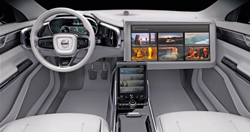|
The age of autonomous vehicles is fast approaching, according to new survey results by the World Economic Forum. Nearly 60% of consumers in cities around the world are willing to travel in self-driving vehicles. In the consumer survey among 5,500 respondents in ten countries, acceptance is highest in emerging markets, such as China, India, and the United Arab Emirates; and about 50% in the United States and  the United Kingdom; acceptance rates were lowest in Japan and Germany. As part of a project, the World Economic Forum also conducted interviews with over 20 city policy makers and transport authorities from cities such as Dubai, Helsinki, New York, Amsterdam, Singapore, and Toronto about their expectations for self-driving vehicles. The survey showed that most city authorities believe that applications such as shared self-driving vehicles are coming very quickly and will have the potential to be the last-mile solution for public transport. City planners and governments thus need to prepare for the introduction of self-driving cars—smart mobility cities such as Gothenburg and Singapore are already doing so. the United Kingdom; acceptance rates were lowest in Japan and Germany. As part of a project, the World Economic Forum also conducted interviews with over 20 city policy makers and transport authorities from cities such as Dubai, Helsinki, New York, Amsterdam, Singapore, and Toronto about their expectations for self-driving vehicles. The survey showed that most city authorities believe that applications such as shared self-driving vehicles are coming very quickly and will have the potential to be the last-mile solution for public transport. City planners and governments thus need to prepare for the introduction of self-driving cars—smart mobility cities such as Gothenburg and Singapore are already doing so.
Volvo Cars’ ongoing research into autonomous driving has confirmed what we all know: that the daily commute is taking the joy out of driving. It is during the commute and on long-haul motorway trips that people are most willing to delegate the act of driving to their car. With this in mind, Volvo has developed Concept 26, named to reflect the average daily commute to work of 26 min, time that could be spent doing something more meaningful than sitting in stop-and-go traffic. Volvo has set out to bring choice and freedom back to drivers so they can enjoy the driving experience when they want to and delegate the driving to the car when they want to do something else.
Concept 26 is based around an all-new patented seat design that actively cradles the driver during the transformation phase into one of the three modes: drive, create, or relax. With these three modes, the concept creates a new autonomous drive innovation platform that can adapt to new needs and technologies over time. When the driver wishes to delegate driving to the car, the steering wheel retracts, the seat reclines, and a large display emerges from the dashboard allowing the driver to enjoy the time spent in the car as he or she likes. Concept 26 opens up a new paradigm of possibilities in the car—from entertainment to service provision and beyond, using the technology that is now a natural part of our everyday lives. It also signals the huge potential for new business opportunities and high-tech collaborations that autonomous drive will bring.
Read the full article: IEEE Vehicular Technology Magazine, Volume 11, Issue 1, March 2016 |